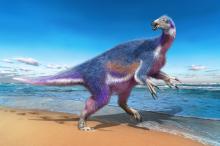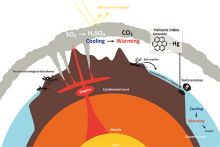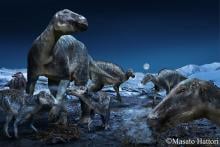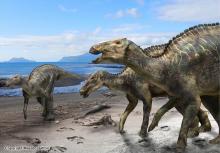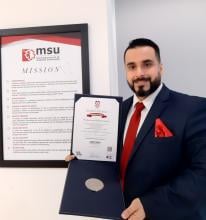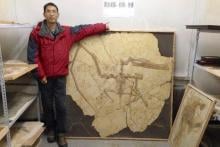Dinosaurs
News
02 Feb 2024
Asia Research News monitors the latest research news in Asia. Some highlights that caught our attention this week are how exercising to music can help cognitive function, a material inspired by a mythological creature, and choking cancer cells using calcium.
26 Jan 2024
Asia Research News monitors the latest research news in Asia. Some highlights that caught our attention this week are a closer step towards artificial spider silk, rocks made from plastic, and why a flightless dinosaur developed small wings.
15 Dec 2023
Asia Research News monitors the latest research news in Asia. Some highlights that caught our attention this week are a motorized tentacle you can wear on your finger, a star that came from a long way away and a long time ago, and a new champion in the competition for the fastest robo-quadruped.
20 Oct 2023
Asia Research News monitors the latest research news in Asia. Some highlights that caught our attention this week are helping to speed up chronic wound healing by gently moving skin cells, distinct species of Japanese honeybees, and how the world’s smallest flowing plant can help astronauts.
11 Aug 2023
Asia Research News monitors the latest research news in Asia. Some highlights that caught our attention this week are particle pollution linked to antibiotic resistance and microplastics being found in the body, fossils that show a marine reptile that used filter feeding, and how a connection in our brains compares our rewards to ones that others received.
28 Jul 2023
Asia Research News monitors the latest research news in Asia. Some highlights that caught our attention this week are a powerful telescope that can catch rogue planets, a new dinosaur species found in Thailand, and 600-million-year-old water droplets.
21 Apr 2023
Asia Research News monitors the latest research news in Asia. Some highlights that caught our attention this week are bioprinting organs and tissues, settling a debate on a monster, and shedding light on dark matter.
17 Feb 2023
Asia Research News monitors the latest research news in Asia. Some highlights that caught our attention this week are the discovery of a dinosaur larynx, 3D-printed contact lenses that use AR, and a leggy robot spider that can fly.
20 Jan 2023
Asia Research News monitors the latest research news in Asia. Some highlights that caught our attention this week are a stem-cell based therapy for pets with cancer, how meditation could affect our gut microbiome, and an edible mushroom that contains a deadly nerve gas.
16 Dec 2022
Asia Research News monitors the latest research news in Asia. Some highlights that caught our attention this week are how we determine which animals we would eat or not, a robot with sticky magnetic feet that can climb, and coriander seeds that had a great holiday in space.
09 Dec 2022
Asia Research News monitors the latest research news in Asia. Some highlights that caught our attention this week are a coat that can make you invisible to AI cameras, a fossilized whale skeleton found in a river valley, and hope for humans after our Y chromosome disappears.
02 Dec 2022
Asia Research News monitors the latest research news in Asia. Some highlights that caught our attention this week are a “smart ranch” featuring connected cows, a way to see what a 1 600-year-old woman looked like, and a new bird-like dinosaur.
18 Nov 2022
Asia Research News monitors the latest research news in Asia. Some highlights that caught our attention this week are the discovery that rats enjoy music like we do, a microrobot that can tickle small insects, and how dinosaurs’ flight differs from birds.
04 Nov 2022
Asia Research News monitors the latest research news in Asia. Some highlights that caught our attention this week are jellyfish-like fossils, mythic diseases, and a transistor that can detect cancer cells.
22 Jul 2022
Asia Research News monitors the latest research news in Asia. Some highlights that caught our attention this week are 100-million-year old dino footprints found in China, horizontal gene transfer between insects, plants and microbes, and when penguins stopped flying.
24 Jun 2022
Asia Research News monitors the latest research news in Asia. Some highlights that caught our attention this week are using your breath to unlock your phone, the first successful launch of a Korean rocket, and the oldest bellybutton to date.
22 Jun 2022
New dinosaur species used claws to graze along the coast, More accurate rainfall predictions, Magnetism helps futuristic cell research, Do compression garments facilitate muscle recovery? Science journalism and why it matters for democracy and our Image of the month. Read all in the June's Editor's Choice and this month's Asia Research News 2022 magazine pick - Lessons from the dead.
17 Jun 2022
Asia Research News monitors the latest research news in Asia. Some highlights that caught our attention this week are babies that dole out punishments, signals that might come from extraterrestrial civilizations, and repelling mosquitos by chewing catnip.
03 Jun 2022
Asia Research News monitors the latest research news in Asia. Some highlights that caught our attention this week are alien civilizations, prehistoric bird diets, and how we smell.
31 May 2022
Scientists have described the youngest therizinosaur fossil from Japan and the first in Asia to have been found in marine sediments.
10 Nov 2020
Researchers in Japan, the US and China say they have found more concrete evidence of the volcanic cause of the largest mass extinction of life. Their research looked at two discrete eruption events: one that was previously unknown to researchers, and the other that resulted in large swaths of terrestrial and marine life going extinct.
27 May 2020
A re-analysis of dinosaur skulls from northern Alaska suggests they belong to a genus that lived over a broad latitudinal range extending into the Arctic.
05 Sep 2019
The dinosaur, whose nearly complete skeleton was unearthed from 72 million year old marine deposits in Mukawa Town in northern Japan, belongs to a new genus and species of a herbivorous hadrosaurid dinosaur, according to the study published in Scientific Reports. The scientists named the dinosaur Kamuysaurus japonicus.
05 Sep 2019
Do you have new research to share about anthropology, archeology, paleontology, sociology, climate change or endangered species? You could win the opportunity to highlight your research in Asia Research News 2020.
19 Sep 2018
The unearthed bones of “Mukawaryu,” Japan’s largest complete dinosaur skeleton, have now been prepared and pieced together, giving us a fuller and clearer image of the 72 million-year-old dinosaur.
Events
Sorry, no events coming up for this topic.
Researchers
Dr. Mohammed N. Abdulrazaq is currently an Assoc. Prof. at Department of Engineering & Technology, Management & Science University (MSU), Malaysia.
Universiti Malaysia Sabah
Dr. Connie Cassy Ompok is an early childhood education expert and a Senior Lecturer at the Faculty of Psychology and Education, Universiti Malaysia Sabah. She Started her career in Early Childhood Education as a preschool teacher (2004-2007), a lecturer in early childhood education at the Malaysian Institute of Teacher Education (2008-2016) before serving as a Senior Lecturer in Early Childhood Education at UMS (2016 until now).
Universiti Teknologi MARA (UiTM)
Dr Heo is currently a senior lecturer at the Department of Microbiology and Parasitology, Faculty of Medicine, Universiti Teknologi MARA, Malaysia.
Giants in history
Palaeontologist Yichun Hao (1920 – 2001) co-authored the first Chinese textbooks on palaeontology and micropalaeontology. Her research on Foraminifera – amoeba-like organisms with shells – was vital for the exploration and utilisation of marine energy resources.
Birbal Sahni (14 November 1891 – 10 April 1949), a pioneer of Indian palaeobotanical research, and founder of what is now the Birbal Sahni Institute of Palaeosciences in Lucknow, made multiple contributions to the study of prehistoric plants. These include the discovery of a new group of fossil gymnosperms (named Pentoxylae), reconstruction of the extinct Williamsonia sewardiana plant, and description of a new type of petrified wood from the Jurassic age.
Lü Junchang (1965–9 October 2018) was a Chinese palaeontologist who is remembered as one of the most important dinosaur researchers of the last 50 years. Lü was an expert on reptiles that lived during the Mesozoic period about 252 million years ago. Cumulatively, Lü and his colleague/competitor Xiaolin Wang described and named more than 50 new species of flying dinosaurs known as pterosaurs.
Rinchen Barsbold (born 21 December 1935) is a Mongolian palaeontologist and geologist who was instrumental in discovering and recovering one of the largest dinosaur collections in the world from the Gobi Desert in Mongolia and China.






















